TL;Dr - Executive Summary
- This article draws its data from multiple annual reports published by the International Narcotics Control Board (INCB).
- Global production of cannabis for medical or scientific purposes peaked in 2021 at a total 907.7 tonnes, and has been gradually decreasing since then to 568.7 tonnes in 2023.
- The top countries consistently ranking in producing the most cannabis for medical and/or scientific purposes are Canada, the UK and Israel.
- The top countries consistently ranking in exporting the most cannabis for medical and/or scientific purposes are the UK, Canada and Portugal.
- The top countries consistently ranking in importing the most cannabis for medical and/or scientific purposes are Germany, the UK, and Israel.
- The top countries consistently ranking in stockpiling the most cannabis for medical and/or scientific purposes are the UK, Colombia and North Macedonia.
- Among these 4 rankings, the single country that always ranks is the UK.
Table of Contents
- What is the INCB?
- How much cannabis produced worldwide for medical & scientific purposes?
- What countries are the top producers of cannabis for medical or scientific purposes?
- What countries are the top exporters of cannabis for medical or scientific purposes?
- What countries are the top importers of cannabis for medical or scientific purposes?
- Which countries held the largest stockpiles of cannabis for medical or scientific purposes?
- How accurate are INCB’s numbers & rankings?
What is the INCB?
The INCB or International Narcotics Control Board, established in 1968, serves as the independent and quasi-judicial body responsible for monitoring the implementation of the United Nations’ international drug control conventions.
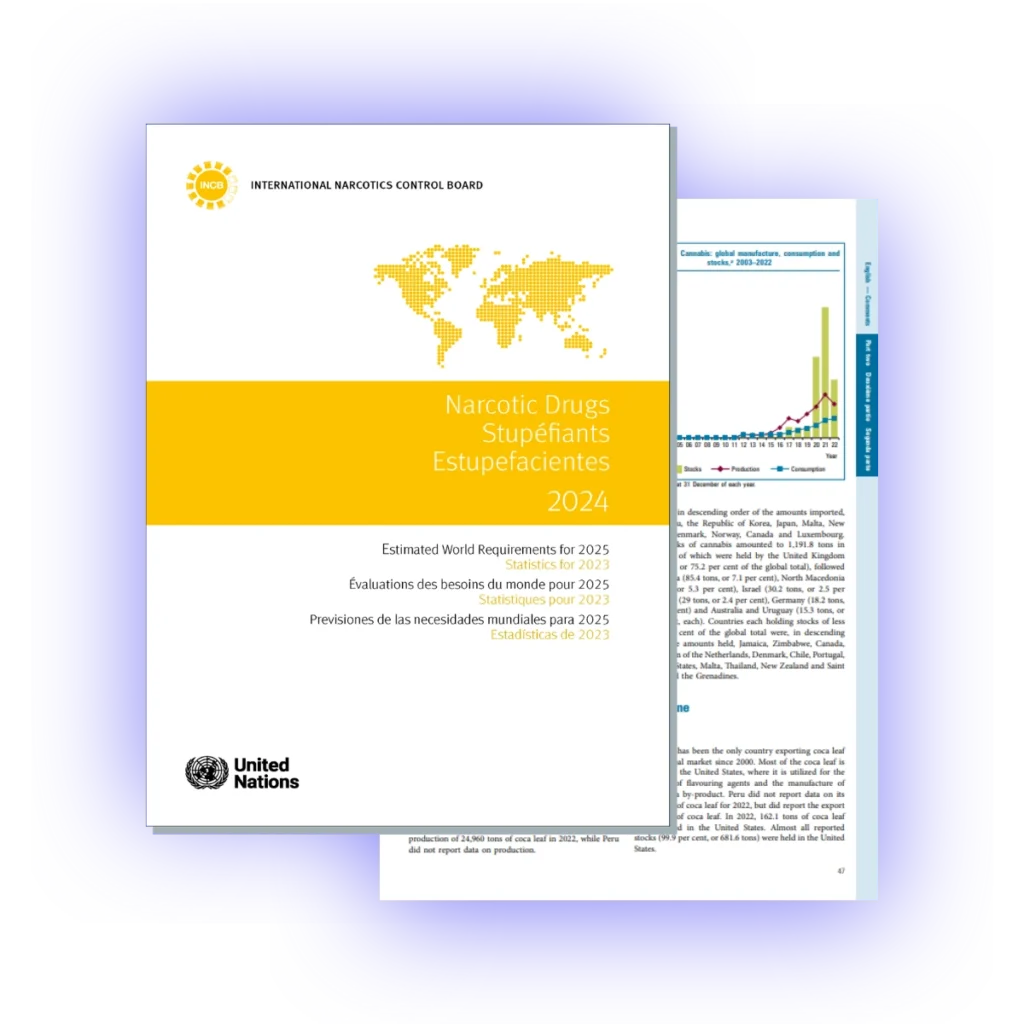
The source of this article's data
The figures and rankings presented in this article were drawn from data taken from INCB’s Technical Reports on Narcotics Drugs published annually.
These reports provide an ‘overview of the worldwide licit manufacture, export, import, stocks and consumption of substances controlled under the Single Convention on Narcotic Drugs of 1961′ – including cannabis.
However, as of August 2025, their latest report only reveals numbers up until 2023.
How much cannabis is produced worldwide for medical & scientific purposes?
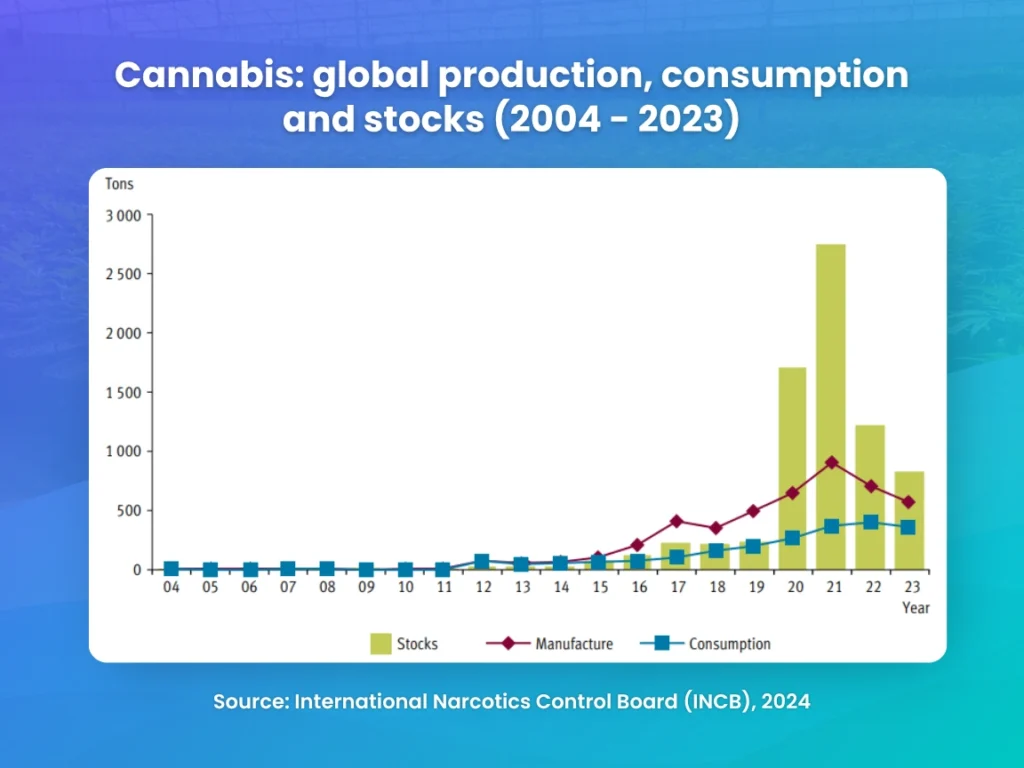
Since 2011, as more and more countries have started using cannabis and cannabis extracts for medical & scientific purposes, there has been an evident increase in its global production.
The INCB’s latest report reveals steady growth in global cannabis production year-on-year from 2004 onwards, hitting a monumental peak in 2021, but gradually decreasing from 2021 to 2023 (as shown in the graph above).
In short, here are the global cannabis production numbers from 2017 to 2023:
- 2017 — 406.1 tonnes — ↑ 196.2t vs 2016
- 2018 — 349.4 tonnes — ↓ 56.7t vs 2017
- 2019 — 468.3 tonnes — ↑ 118.9t vs 2018
- 2020 — 650.8 tonnes — ↑ 182.5t vs 2019
- 2021 — 907.9 tonnes — ↑ 257.1t vs 2020, currently holding the record for global cannabis production
- 2022 — 707.4 tonnes — ↓ 200.5t vs 2021
- 2023 — 568.7 tonnes — ↓ 138.7t vs 2022
Why was 2021 a record year for cannabis production?
In the years leading up to 2021, dozens of countries worldwide legalised or broadened their medical cannabis programs. Most notably, in December 2020, the United Nations removed cannabis from Schedule IV of the 1961 Single Convention on Narcotic Drugs – effectively allowing its use for medical treatment and stimulating the creation of national programs.
To capitalise on the potentially lucrative opportunity, many countries ramped up their production of cannabis in a bid to meet forecasted demand – which at the time was boosted by the stay-at-home orders & stress induced by the COVID-19 lockdowns. Sales at this time skyrocketed by roughly 40% in 2020, and 30% in 2021 – outpacing normal growth rates.
However, this one-time 2021 peak driven by special conditions has since slowed, with demand stabilising back to pre-pandemic levels. As a result, global cannabis production decreased accordingly to avoid substantial losses.
What countries are the top producers of cannabis for medical or scientific purposes?
According to INCB’s reports from 2021 to 2024 summarised in the table below, the countries who consistently rank in the production of cannabis for medical and/or scientific purposes are Canada, United Kingdom (UK) and Israel.
2023 - Top 5 countries for cannabis production
As of INCB’s latest 2023 stats, the top 5 countries in cannabis production are:
- Canada — 160.8 tonnes, or 28.8% of global production
- UK — 109.5 tonnes, or 19.2% of global production
- Israel — 65.5 tonnes, or 11.5% of global production
- Portugal — 42 tonnes, or 7.4% of global production
- Uruguay — 28.6 tonnes, or 5% of global production
2022 - Top 5 countries for cannabis production
According to the INCB’s report of 2022, the top 5 countries in cannabis production are:
- Canada — 235.9 tonnes, or 33.3% of global production
- UK — 190.9 tonnes, or 25.5% of global production
- Israel — 73.2 tonnes, or 10.3% of global production
- Portugal — 41.9 tonnes, or 5.9% of global production
- North Macedonia — 40.4 tonnes, or 5.7% of global production
2021 - Top 5 countries for cannabis production
According to the INCB’s report of 2021, the top 5 countries in cannabis production are:
- UK — 329.1 tonnes, or 43% of global production
- Italy — 150 tonnes, or 19.7% of global production
- Israel — 89.4 tonnes, or 11.7% of global production
- Colombia — 45.3 tonnes, or 5.9% of global production
- Jamaica — 34.9 tonnes, or 4.6% of global production
2020 - Top 5 countries for cannabis production
According to the INCB’s report of 2020, the top 5 countries in cannabis production are:
- UK — 238.7 tonnes, or 36.7% of global production
- Canada — 227.8 tonnes, or 35% of global production
- Spain — 84.4 tonnes, or 13% of global production
- Israel — 24.6 tonnes, or 3.8% of global production
- Australia — 18.4 tonnes,
or 2.8% of global production
Top 5 countries by total tonnage of cannabis produced (from 2020-2023)
Below are the top 5 countries ranked in terms of total tonnage of cannabis produced from 2020 to 2023, based on INCB’s data. Evidently, though Canada ranks as the top producer in the most recent years, the UK still has cumulatively produced more.
- UK — 858.2 tonnes
- Canada — 624.5 tonnes
- Israel — 228.1 tonnes
- Spain — 131.1 tonnes
- North Macedonia — 93.9 tonnes
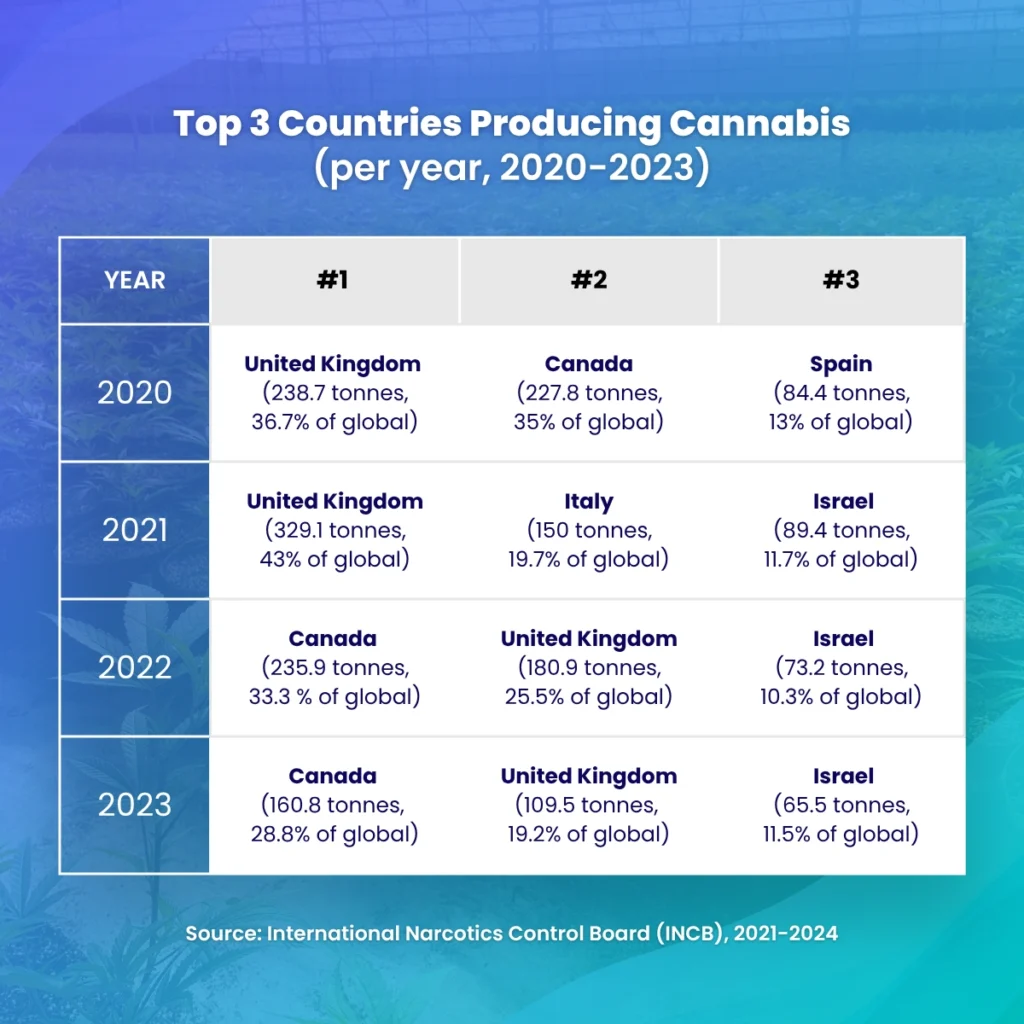
What countries are the top exporters of cannabis for medical or scientific purposes?
According to INCB’s reports from 2021 to 2024 summarised in the table below, the countries who consistently rank in the export of cannabis for medical and/or scientific purposes are the UK, Canada & Portugal.
2023 - Top 5 countries for cannabis exports
As of INCB’s latest 2023 stats, the top 5 countries in exporting cannabis are:
- Canada — 141 tonnes, or 41.4% of global production
- UK — 124.1 tonnes, or 36.4% of global production
- Portugal — 21.7 tonnes, or 6.3% of global production
- Finland— 20.1 tonnes, or 5.9% of global production
- Netherlands — 7.6 tonnes, or 2.2% of global production
2022 - Top 5 countries for cannabis exports
According to INCB’s report of 2022, the top 5 countries in exporting cannabis are:
- UK — 266 tonnes, or 64.7% of global production
- Canada — 96.1 tonnes, or 23.4% of global production
- Portugal — 16.5 tonnes, or 4% of global production
- Netherlands— 7.2 tonnes, or 1.7% of global production
- Denmark — 5 tonnes, or 1.3% of global production
2021 - Top 5 countries for cannabis exports
According to INCB’s report of 2021, the top 5 countries in exporting cannabis are:
- UK — 212.9 tonnes, or 58.4% of global production
- Canada — 87 tonnes, or 23.9% of global production
- Finland — 28.3 tonnes, or 7.8% of global production
- Portugal— 12.1 tonnes, or
3.3% of global production - Netherlands — 8.1 tonnes, or 2.2% of global production
2020 - Top 5 countries for cannabis exports
According to INCB’s report of 2020, the top 5 countries in exporting cannabis are:
- Canada — 88.4 tonnes, or 74.5% of global production
- Portugal — 7.3 tonnes, or 6.2% of global production
- Lesotho — 6.1 tonnes, or 5.1% of global production
- USA — 5.2 tonnes, or 4.4% of global production
- Netherlands — 3.6 tonnes, or 3% of global production
Top 5 countries by total tonnage of cannabis exported (from 2020-2023)
Here are the top 5 countries ranked in terms of total tonnage of cannabis exported from 2020 to 2023, based on INCB’s data:
- UK — 603 tonnes
- Canada — 412.5 tonnes
- Portugal — 57.6 tonnes
- Finland — 48.4 tonnes
- Netherlands — 26.5 tonnes
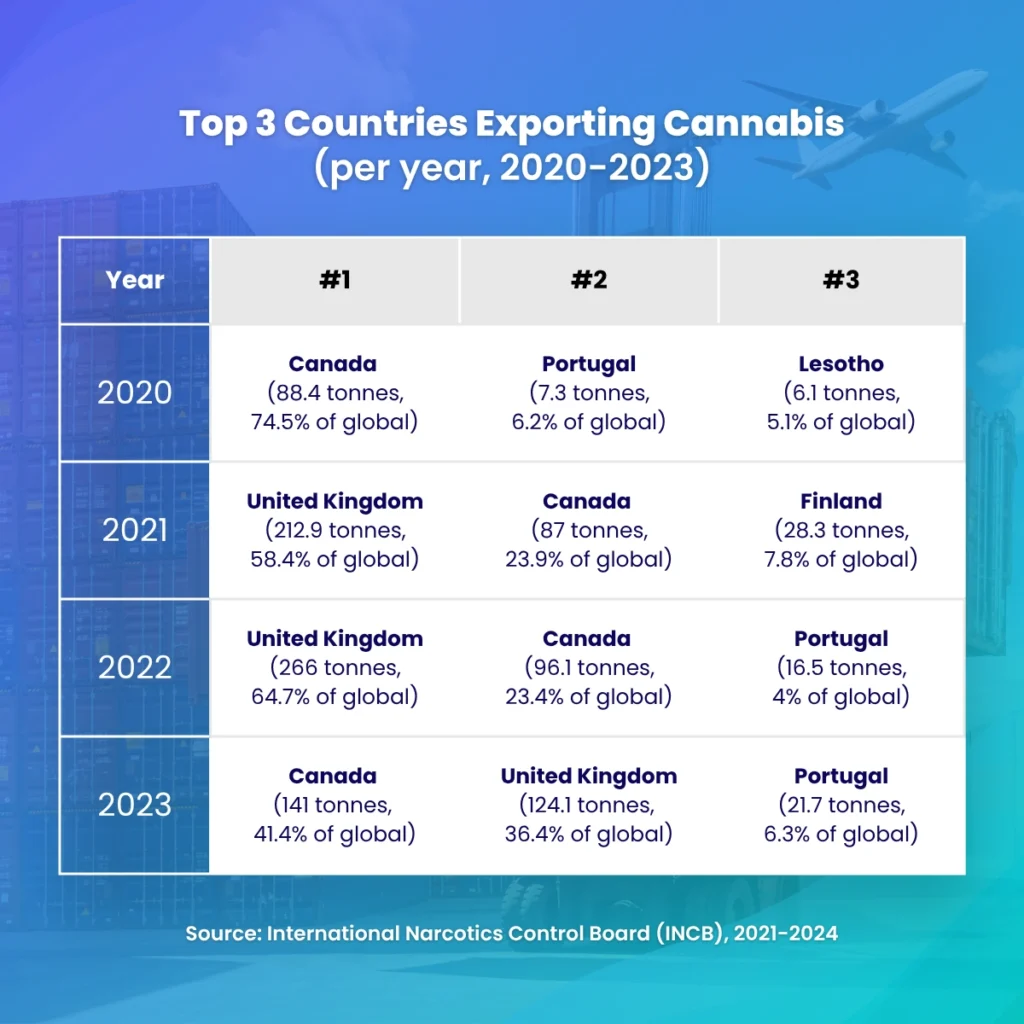
What countries are the top importers of cannabis for medical or scientific purposes?
According to INCB’s reports from 2021 to 2024 summarised in the table below, the countries who consistently rank in the import of cannabis for medical and/or scientific purposes are Germany, the UK and Israel.
2023 - Top 5 countries in cannabis imports
As of INCB’s latest 2023 stats, the top 5 countries in terms of cannabis imports are:
- Germany — 35.6 tonnes, or 25% of global production
- UK — 27.3 tonnes, or 19.2% of global production
- Australia — 25 tonnes, or 17.6% of global production
- Israel — 15.9 tonnes, or 11.2% of global production
- Portugal — 13.2 tonnes, or 9.3% of global production
2022 - Top 5 countries in cannabis imports
According to INCB’s report of 2022, the top 5 countries in terms of cannabis imports are:
- Germany — 26.8 tonnes, or 23.3% of global production
- Finland — 22.5 tonnes, or 19.6% of global production
- Israel — 14.5 tonnes, or 12.6% of global production
- Australia — 11.5 tonnes, or 10% of global production
- Spain — 7.2 tonnes, or 6.3% of global production
2021 - Top 5 countries in cannabis imports
According to INCB’s report of 2021, the top 5 countries in terms of cannabis imports are:
- UK — 31.5 tonnes, or 25.2% of global production
- Israel — 25.5 tonnes, or 20.3% of global production
- Germany — 22.5 tonnes, or 18% of global production
- Ireland — 15 tonnes, or 12% of global production
- Portugal — 6.8 tonnes, or
5.4% of global production
2020 - Top 5 countries in cannabis imports
According to INCB’s report of 2020, the top 5 countries in terms of cannabis imports are:
- Germany — 16.2 tonnes, or 17.2% of global production
- Denmark — 15.8 tonnes, or 16.8% of global production
- Finland — 15.5 tonnes, or 16.5% of global production
- Israel — 14.6 tonnes, or 15.5% of global production
- Portugal — 5.3 tonnes, or 5.6% of global production
Top 5 countries by total tonnage of cannabis imported (from 2020-2023)
Here are the top 5 countries ranked in terms of total tonnage of cannabis imported from 2020 to 2023, based on INCB’s data:
- Germany — 101.1 tonnes
- Israel — 70.5 tonnes
- UK — 63.9 tonnes
- Finland — 38 tonnes
- Portugal — 25.3 tonnes
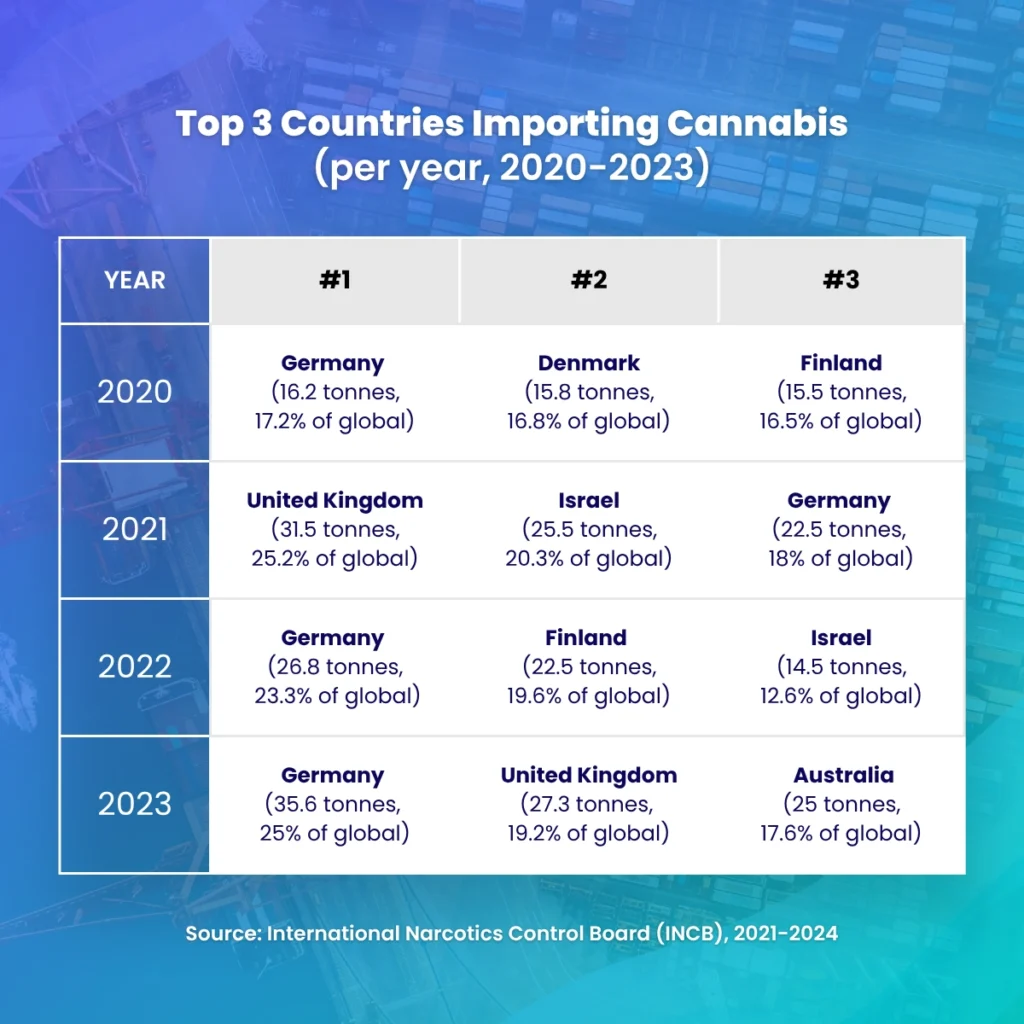
Which countries held the largest stockpiles of cannabis for medical or scientific purposes?
According to INCB’s reports from 2021 to 2024 summarised in the table below, the countries who consistently rank in stocking cannabis for medical and/or scientific purposes are the UK, Colombia & North Macedonia.
2023 - Top 5 countries in stockpiling cannabis
As of INCB’s latest 2023 stats, the top 5 countries stockpiling the most cannabis are:
- UK — 507 tonnes, or 61.3% of global production
- Colombia — 81.3 tonnes, or 9.8% of global production
- North Macedonia — 55.9 tonnes, or 6.7% of global production
- Australia — 38 tonnes, or 4.6% of global production
- Israel — 23.8 tonnes, or 2.8% of global production
2022 - Top 5 countries in stockpiling cannabis
According to INCB’s report of 2022, the top 5 countries stockpiling the most cannabis are:
- UK — 896.5 tonnes, or 75.2% of global production
- Colombia — 85.4 tonnes, or 7.1% of global production
- North Macedonia — 63.8 tonnes, or 5.3% of global production
- Israel — 30.2 tonnes, or 2.5% of global production
- Spain — 29 tonnes, or 2.4% of global production
2021 - Top 4 countries in stockpiling cannabis
According to INCB’s report of 2021, the top 4 countries stockpiling the most cannabis are:
- UK — 2,515 tonnes, or 92% of global production
- Colombia — 47.7 tonnes, or 1.8% of global production
- North Macedonia — 39.3 tonnes, or 1.4% of global production
- Denmark — 32.4 tonnes, or 1.2% of global production
Thre are only 4 countries on this list because the amount of cannabis stockpiled by the remainder of countries was negligible (each holding less than 1%). In descending order of amount stockpiled, the remaining countries were Israel, Spain, Australia, Germany, Jamaica, Uruguay, the Netherlands, Chile, Finland, the United States, Malta, Switzerland, Thailand, France, Belgium and New Zealand.
2020 - Top 5 countries in stockpiling cannabis
According to INCB’s report of 2020, the top 5 countries stockpiling the most cannabis are:
- UK — 1489.2 tonnes, or 85.2% of global production
- Spain — 88.9 tonnes, or 5.2% of global production
- Canada — 49.3 tonnes, or 2.9% of global production
- Denmark and Finland— each country stockpiled 20 tonnes, or 1.2% of global production each
Top 5 countries by lagest cannabis stockpile held at any one time (from 2020-2023)
Here are the top 5 countries ranked in terms of most cannabis stockpiled at any one time from 2020 to 2023, based on INCB’s data:
- UK — 2,515 tonnes (2021)
- Spain — 88.9 tonnes (2020)
- Colombia — 85.4 tonnes (2022)
- North Macedonia — 63.8 tonnes (2022)
- Canada — 49.3 tonnes (2020)
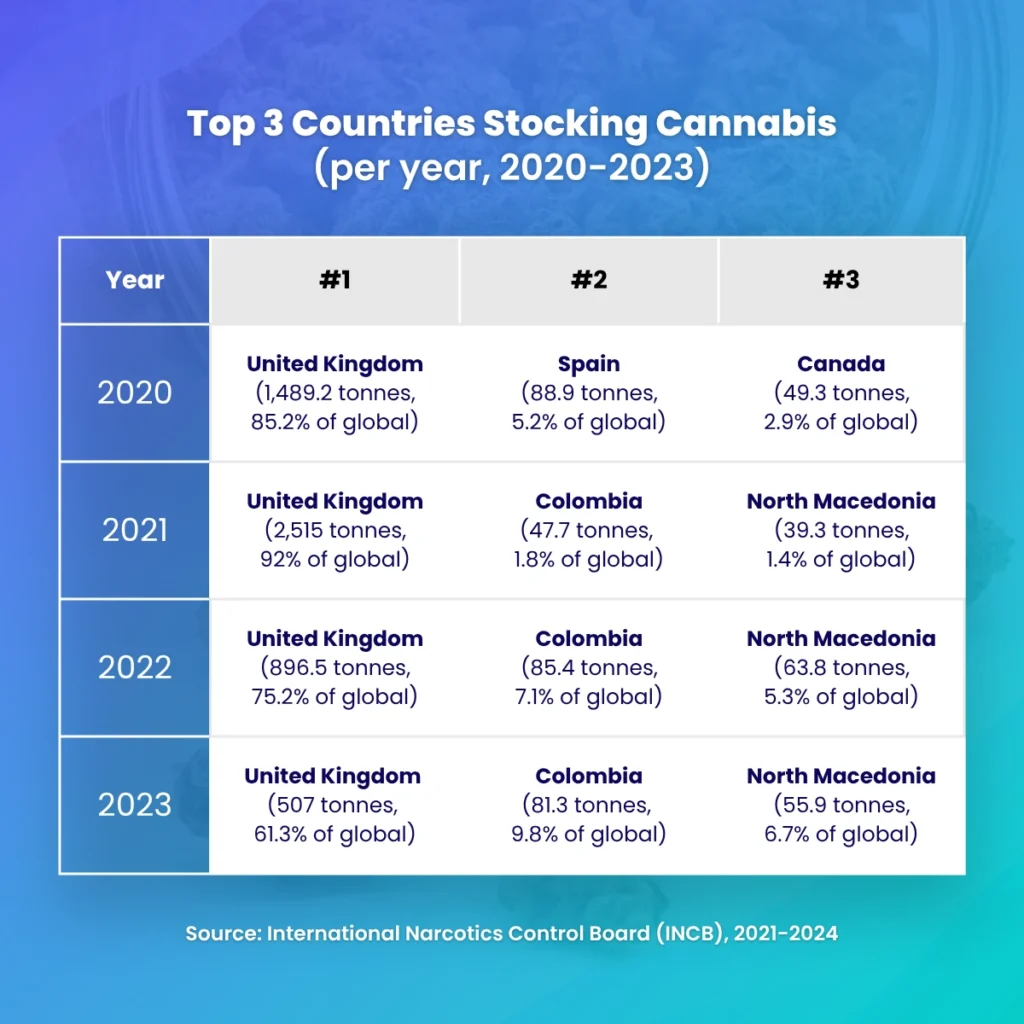
How accurate are INCB's numbers & rankings?
While most of the data presented by INCB align with what we’ve heard and seen over half a decade working closely with cannabis industry leaders, there were some incongruities.
A big one was in the case of Canada. While the INCB reports Canada produces “x” amount of cannabis, other sources reveal Canada destroys a much higher amount – suggesting the country could, in fact, be producing much more than is reported.
For example, Canada was not listed on INCB’s ranking for cannabis production in 2021, but this article from MJBizDaily reveals that Canada, in fact, destroyed 468.8 tonnes of unsold cannabis that same year – higher than the amount produced by that year’s top country, the UK (329.1 tonnes).
Limitations of the INCB
The INCB compiles annual data submitted by member states (via “Form C”) on licit cultivation, production, and trade for medical or scientific purposes. As such, it has the following limitations which may lead to underreporting.
- Recreational Market is Disregarded
The INCB does not report on cannabis that is not produced or traded strictly for medical or scientific purposes. Limited Mandate & No Enforcement
The INCB monitors treaty compliance and reporting but lacks enforcement power to verify or mandate data accuracy.Transparency Concerns
The INCB has been criticized for its opaque processes and limited engagement with civil society, leading NGOs to call for increased transparency and accountability.
Could tonnes of cannabis go unreported?
Yes – various factors contribute to potential underreporting:
- Self-Reporting Reliance
Governments submit their own data. As such, there is a big potential for data to be incomplete or skewed. - Voluntary Reporting for Some Categories
Reporting of industrial hemp or CBD production is often voluntary. Reporting obligations under the UN conventions are unclear or not mandatory for these categories, meaning many activities might not be captured. Illicit Market & Small-Scale Cultivation
Cannabis is often produced informally or illicitly by local or small-scale growers. Such cultivation rarely enters official channels and is essentially invisible in INCB data.
Stay tuned for 2024 and 2025 updates!
As mentioned in the beginning of the article, the INCB has only released data up until 2023.
Considering Germany’s partial legalisation in 2024, and France’s gradual opening of its medical cannabis market in more recent years, the most exciting data is yet to be revealed.
Lumino will continue to update this page as new numbers from INCB are published.
Bookmark this page for future reference!



